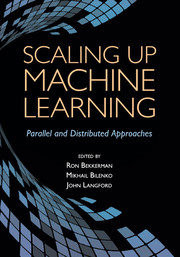Book contents
- Frontmatter
- Contents
- Contributors
- Preface
- 1 Scaling Up Machine Learning: Introduction
- Part One Frameworks for Scaling Up Machine Learning
- Part Two Supervised and Unsupervised Learning Algorithms
- Part Three Alternative Learning Settings
- Part Four Applications
- 18 Large-Scale Learning for Vision with GPUs
- 19 Large-Scale FPGA-Based Convolutional Networks
- 20 Mining Tree-Structured Data on Multicore Systems
- 21 Scalable Parallelization of Automatic Speech Recognition
- Subject Index
- References
18 - Large-Scale Learning for Vision with GPUs
from Part Four - Applications
Published online by Cambridge University Press: 05 February 2012
- Frontmatter
- Contents
- Contributors
- Preface
- 1 Scaling Up Machine Learning: Introduction
- Part One Frameworks for Scaling Up Machine Learning
- Part Two Supervised and Unsupervised Learning Algorithms
- Part Three Alternative Learning Settings
- Part Four Applications
- 18 Large-Scale Learning for Vision with GPUs
- 19 Large-Scale FPGA-Based Convolutional Networks
- 20 Mining Tree-Structured Data on Multicore Systems
- 21 Scalable Parallelization of Automatic Speech Recognition
- Subject Index
- References
Summary
Computer vision is a challenging application area for learning algorithms. For instance, the task of object detection is a critical problem for many systems, like mobile robots, that remains largely unsolved. In order to interact with the world, robots must be able to locate and recognize large numbers of objects accurately and at reasonable speeds. Unfortunately, off-the-shelf computer vision algorithms do not yet achieve sufficiently high detection performance for these applications. A key difficulty with many existing algorithms is that they are unable to take advantage of large numbers of examples. As a result, they must rely heavily on prior knowledge and hand-engineered features that account for the many kinds of errors that can occur. In this chapter, we present two methods for improving performance by scaling up learning algorithms to large datasets: (1) using graphics processing units (GPUs) and distributed systems to scale up the standard components of computer vision algorithms and (2) using GPUs to automatically learn high-quality feature representations using deep belief networks (DBNs). These methods are capable of not only achieving high performance but also removing much of the need for hand-engineering common in computer vision algorithms.
The fragility of many vision algorithms comes from their lack of knowledge about the multitude of visual phenomena that occur in the real world. Whereas humans can intuit information about depth, occlusion, lighting, and even motion from still images, computer vision algorithms generally lack the ability to deal with these phenomena without being engineered to account for them in advance.
- Type
- Chapter
- Information
- Scaling up Machine LearningParallel and Distributed Approaches, pp. 373 - 398Publisher: Cambridge University PressPrint publication year: 2011

